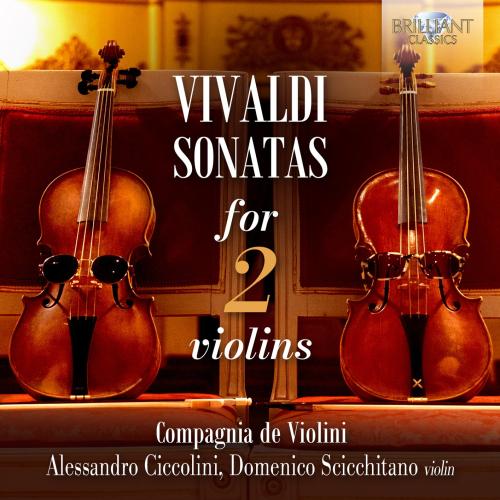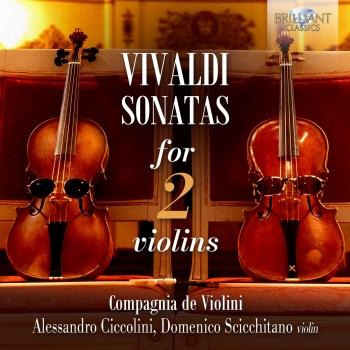
Vivaldi: Sonatas for 2 Violins Alessandro Ciccolini, Domenico Scicchitano, Compagnia de Violini
Album info
Album-Release:
2024
HRA-Release:
26.01.2024
Label: Brilliant Classics
Genre: Classical
Subgenre: Instrumental
Artist: Alessandro Ciccolini, Domenico Scicchitano, Compagnia de Violini
Composer: Antonio Vivaldi (1678-1741), Andrea Zani (1696-1757)
Album including Album cover Booklet (PDF)
- Andrea Zani (1696 - 1757) Antonio Vivaldi (1678 - 1741): Sonata in F Major, RV 70:
- 1 Zani, Vivaldi: Sonata in F Major, RV 70: I. Allegro 04:54
- 2 Zani, Vivaldi: Sonata in F Major, RV 70: II. Larghetto 05:35
- 3 Zani, Vivaldi: Sonata in F Major, RV 70: III. Allegro Molto 03:32
- Sonata in G Major, RV 71:
- 4 Zani, Vivaldi: Sonata in G Major, RV 71: I. Allegro 04:50
- 5 Zani, Vivaldi: Sonata in G Major, RV 71: II. Larghetto 04:32
- 6 Zani, Vivaldi: Sonata in G Major, RV 71: III. Allegro 04:21
- Sonata in F Major, RV 68:
- 7 Zani, Vivaldi: Sonata in F Major, RV 68: I. Allegro 05:00
- 8 Zani, Vivaldi: Sonata in F Major, RV 68: II. Andante 02:24
- 9 Zani, Vivaldi: Sonata in F Major, RV 68: III. Allegro 03:50
- Sonata in B-Flat Major, RV 77:
- 10 Zani, Vivaldi: Sonata in B-Flat Major, RV 77: I. Allegro 05:40
- 11 Zani, Vivaldi: Sonata in B-Flat Major, RV 77: II. Andante 05:43
- 12 Zani, Vivaldi: Sonata in B-Flat Major, RV 77: III. Allegro 03:42
- Andrea Zani: Duetto in E-Flat Major:
- 13 Zani: Duetto in E-Flat Major: I. No name (Largo) 06:18
- 14 Zani: Duetto in E-Flat Major: II. Allegro 06:21
- 15 Zani: Duetto in E-Flat Major: III. Allegro 04:16
- 16 Zani: Duetto in E-Flat Major: IV. Minuè 01:09
- Canone tempo Giusto:
- 17 Zani: Canone tempo Giusto 02:06
Info for Vivaldi: Sonatas for 2 Violins
Vivaldi’s Sonatas for two violins, anco senza basso se piace (also without bass if preferred), represent one of the innumerable peaks of his compositional prowess. They are structured in three movements, each of which develops in a bipartite manner, making evident reference to concerto form, with only the internal bipartite structure alluding to sonata form. This distinguishes Vivaldi’s approach to the duo without bass from that of some of his European colleagues, namely Telemann (Sonates sans basse, 1727) and Leclair (Sonates à deux violons sans basse Op.3, 1730).
The palette of colours and expressive effects used by Vivaldi in these sonatas is truly impressive: arpeggios, double stops, high-register passages, extremely complex articulations requiring exceptional bow technique, ornate cantabile lines (to be further ornamented by the performer) and even more radical cantabile in the central movements. Here, Vivaldi’s mastery is evident in a sensitive use of lines that are disarming in their simplicity yet tremendously expressive, using a modest language of triplets, appogiaturas and Lombard rhythms in perfect amounts to maximum effect.
A handwritten inventory of the music collection of the noble Collalto family at Brtnice attests along with 15 concertos by Vivaldi to a Duetto, or rather, a Sonata for 2 violins in five movements by one Andrea Zani, a composer who emulated Vivaldi’s music and style to the degree that historians assume Zani studied under Vivaldi for a time. (That being said, Zani stands out as one of the purest and most interesting composers of instrumental music in Italy in the first half of the 18th century. His works – at once original and innovative – are largely yet to be studied and performed.) Sadly all that survives of the Collalto collection is that inventory, but Zani’s Duetto has come down to us via three sources preserved in Sweden. As in Vivaldi’s compositions, the movements in Zani’s work are bipartite in form. Zani, too, establishes the colour palette of his compositions with highly effective progressions, employing the whole expressive armoury fielded by his idol, Vivaldi. Zani’s writing also makes frequent use of a great rhythmic propulsion. Finally, and in contrast to Vivaldi, Zani did not provide a bass ad libitum, indicating his clear intent for duo rather than trio sonata performance.
Alessandro Ciccolini, violin
Domenico Scicchitano, violin
Compagnia de Violini
It is from the meeting between the violinist Alessandro Ciccolini and the harpsichordist and organist Francesco Baroni that, after twenty-five years of often shared concert activity, was born the idea of giving life to a new group dedicated to the performance of the Baroque repertoire on original instruments.
The common passion for teaching and philological research finds its ideal fulfillment in the foundation of an ensemble that could combine the recovery of the unpublished Italian repertoire , with particular attention to the tradition of the Baroque musical history of Parma, with the future of the younger generation of musicians who intend to seriously deepen the research and study of the repertoire of this historical period.
Finally, it was decided to form, or rather to reconstitute the Compagnia de Violini , a historical group of violinists active at the Farnese court between the late 16th and early 17th centuries.
Booklet for Vivaldi: Sonatas for 2 Violins









